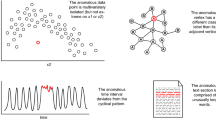Abstract
Data glitches are errors in a dataset. They are complex entities that often span multiple attributes and records. When they co-occur in data, the presence of one type of glitch can hinder the detection of another type of glitch. This phenomenon is called masking. In this paper, we define two important types of masking and propose a novel, statistically rigorous indicator called masking index for quantifying the hidden glitches. We outline four cases of masking: outliers masked by missing values, outliers masked by duplicates, duplicates masked by missing values, and duplicates masked by outliers. The masking index is critical for data quality profiling and data exploration. It enables a user to measure the extent of masking and hence the confidence in the data. In this sense, it is a valuable data quality index for choosing an anomaly detection method that is best suited for the glitches that are present in any given dataset. We demonstrate the utility and effectiveness of the masking index by intensive experiments on synthetic and real-world datasets.











Similar content being viewed by others
Notes
Data set from OpenData by Socrata retrieved on March 26, 2013: https://opendata.socrata.com/Government/Unclaimed-bank-accounts/.
Permanent Service for Mean Sea level—PSMSL: http://www.psmsl.org/.
References
Acuna E, Rodriguez CA (2004) Meta analysis study of outlier detection methods in classification, IPSI
Barnett V, Lewis T (1994) Outliers in statistical data. Wiley, New York
Ben-Gal I (2005) Outlier detection. In: Maimon O, Rockach L (eds) Data mining and knowledge discovery handbook: a complete guide for practitioners and researchers. Kluwer, Dordrecht
Berti-Equille L, Dasu T, Srivastava D (2011) Discovery of complex glitch patterns: a novel approach to quantitative data cleaning, ICDE, pp 733–744
Blake R, Mangiameli P (2011) The effects and interactions of data quality and problem complexity on classification. J Data Inf Qual 2(2):8:1–8:28
Dasu T, Loh JM (2012) Statistical distortion: consequences of data cleaning. PVLDB 5(11):1674–1683
Davies L, Gather U (1993) The identification of multiple outliers. J Am Stat Assoc 88(423):782–792
Efron B (1979) Bootstrap methods: another look at the jackknife. Ann Stat 7:1–26
Hawkins D (1980) Identification of outliers. Chapman and Hall, London
Iglewics B, Martinez J (1982) Outlier detection using robust measures of scale. J Stat Comput Simul 15:285–293
Kushmerick N (1999) Learning to remove internet advertisements. In: Proceedings of the third annual conference on autonomous agents, AGENTS ’99, pp 175–181
Rao CR (1973) Linear statistical inference and its applications. Wiley, New York
Xiong H, Pandey G, Steinbach M, Kumar V (2006) Enhancing data analysis with noise removal. IEEE Trans Knowl Data Eng 18(2):304–319
Author information
Authors and Affiliations
Corresponding author
Rights and permissions
About this article
Cite this article
Berti-Équille, L., Loh, J.M. & Dasu, T. A masking index for quantifying hidden glitches. Knowl Inf Syst 44, 253–277 (2015). https://doi.org/10.1007/s10115-014-0760-0
Received:
Revised:
Accepted:
Published:
Issue Date:
DOI: https://doi.org/10.1007/s10115-014-0760-0




